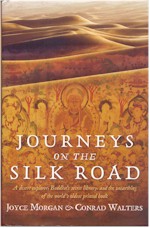 |
|
|
| ||||||
|
|
This page is the original source of this review, though you may also find it on Amazon or other sites. | ||
| Book Reviews Home | Free Audio Books | |
 |
Book Review of: Journeys on the Silk RoadA desert explorer, Buddha's secret library, and the unearthing of the world's oldest printed book Price: $24.95 Availability: Usually ships within 24 hours |
| Review of
Journeys on the Silk Road, by Joyce Morgan and Conrad Walters (Hardcover, 2012) (You can print this review in landscape mode, if you want a hardcopy) Reviewer: Mark Lamendola, author of over 6,000 articles. Prior to the advent of steam-engine ships, the silk road provided the only viable trade route between Europe and China (also India). Thus, for centuries, it was a vital overland crossing. It's important to note that China had several industrial secrets, among them the production of silk. This gave China a monopoly on silk, and this particular monopoly gave rise to the practice of calling this route the Silk Road. China also had a monopoly on paper for quite some time, and it was an important source of various spices and other goods. Because Buddhism spread from India throughout much of Asia before retracting/retreating mainly to Tibet, the Silk Road also became a repository for Buddhist writings. This book's focus is on the retrieval of many of those writings by Hungarian-British archaeologist Aurel Stein in the early 20th Century. Stein was later knighted, so he is properly referred to as Sir Stein. His dog Dash (he had several dogs, each named Dash except for one who was named Dash the Great). The last Dash died after being run over by a bus in England, but Sir Stein, born in 1862 died peacefully in 1943. Stein doesn't strike the popular imagination for several reasons, and the authors explain that in this book. Having never heard of it before, I had no idea what this sutra meant. Morgan and Walters solved that problem. They provide opinions from various experts, including His Holiness the Dalai Lama. It added to my reading experience to go beyond the "here's what happened a century ago" to "here's what it means today."
A related factor, one that's been written about in magazines and newspapers even this year, is the desire of the Chinese government to reclaim for China artifacts that were legally extracted from China to European museums but today the Chinese government considers to be stolen. Unfortunately, this means the Chinese hold Stein in low regard. He was a hero to the west, but is a villain to the Chinese. The richness of detail and the very solid writing by these authors made the reading of this book a pleasure. The fact it was well-researched and highly accurate added to the sense of reading something special. The authors have traveled widely, and have been published internationally. Walters, in fact, has lived in seven countries. This might help explain how they managed to write such that I frequently felt as if I were there with Stein, and understood his challenges. I also liked the fact that they didn't marginalize the non-Europeans, as Eurocentric authors are prone to do. In fact, they took care to show us that Stein held several of these individuals in great regard and treated them with dignity and respect. Morgan and Walters tie this story to the present, particularly by addressing the scroll that contained the Diamond Sutra. Dating back to the middle of the 9th century, this is the oldest printed book known to mankind. Yes, the oldest printed book. Gutenberg didn't invent block printing, the Chinese did (they also invented paper, gun powder, and other items we don't normally associate with China). I always like a good history book, and this one ranks right up there with the best. Journeys on the Silk Road is informative and captivating. It's an easy read, and it seems to follow all of the rules of good writing. When you're done reading the book, you know you understood what you just read. At no point did I scratch my head and go back to a previous page in an effort to decipher what I just read on the current page. The writing was clear, the whole way through. I effortlessly moved from start to finish, and enjoyed the journey. It's been an unfortunate trend for "journalists" whose day job is at some disinformation ("news") paper to write an alleged nonfiction work on history mainly for the purpose of proselytizing their statist fantasies. When I saw the authors' credentials included some newspaper posts, red flags went up. However, I didn't find a single scrap of propaganda or related drivel in this book. The authors didn't deviate from what they promised to deliver in the book's title and subtitle. This book includes 19 chapters across 283 pages. After the table of contents is a grayscale map of the Silk Road area. This is followed by a two-page Prologue. After the last chapter, there's a two-page postscript (it tells you what happened to various characters in the book). One of the remarkable things mentioned in the postscript is that an Afghan man named Rahimullah tended Stein's grave (it's in the British Cemetery in Kabul) for nearly thirty years. Rahimullah died of natural causes in 2010, and his son Abdul Samay took over that role. Quite a few people made this book happen, as evidenced in the acknowledgements. That's followed by 19 pages of end notes and a 6-page bibliography. | |
| |||||